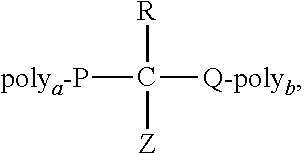Process for the preparation of poly(alkylene oxide) derivatives for modification of biologically active molecules and materials
a technology of alkylene oxide and derivatives, which is applied in the field of improved methods for preparing poly (alkylene oxide) derivatives, can solve the problems of succinimidyl carbonate, useful for pegylation, and chloroformates that are not useful for the synthesis of poly-imsup
- Summary
- Abstract
- Description
- Claims
- Application Information
AI Technical Summary
Benefits of technology
Problems solved by technology
Method used
Image
Examples
example 1
Synthesis of mPEG(20 kDa)-OC(O)-Im (1)
[0072]Commercially available mPEG (20 kDa) (12.600 g, 6.3 10−4 mol) was dissolved in anhydrous THF (60 mL) at 60° C. CDI (0.293 g, 1.81 10−3 mol) was added and the solution was stirred at 60° C. for 18 hours. The solvent was removed under vacuum.
[0073]The residue was dissolved in water (100 mL) and then five-fold extracted with chloroform (5×100 mL). The organic phase was evaporated at reduced pressure and dried (5 mmHg) until constant weight. Yield: 97-99%. 1H-RMN (300 MHz-Cl3CD): 3.35 ppm (s, 3H, OMe); 3.60 ppm (brs, mPEG backbone); 4.43-4.52 ppm (m, superimposed on mPEG backbone peak, CH2OC(O)); 7.04 ppm (s, 1H, Im-H); 7.40 ppm (s, 1H, Im-H); 8.11 ppm (s, 1H, Im-H).
example 2
Synthesis of mPEG(20 kDa)-OC(O)-(ImMe)⊕I⊖(2)
[0074]The mPEG(20 kDa)-OC(O)-Im (2.000 g, 1 10−4 mol) obtained in Example 1 was dissolved in ACN (10 mL) at room temperature. Methyl iodide was added (1 mL, 1.6 10−2 mol), and the solution was stirred at room temperature for 16 hours. The solvent was removed under reduced pressure and the resulting solid residue was dried (5 mmHg) until constant weight. Yield: 95-99%. 1H-RMN (300 MHz-Cl3CD): 3.36 ppm (s, 3H, OMe); 3.63 ppm (brs, mPEG backbone); 3.86 ppm (m, superimposed on mPEG backbone peak, CH2OC(O)); 4.06 ppm (s, 3H, CH3); 7.51 ppm (s, 2H, 2×Im-H); 9,96 ppm (s, 1H, Im-H).
example 3
Synthesis of mPEG(20 KDa)-OC(O)-Lys-(O)CO-mPEG(20 KDa) (3)
[0075]a) Preparation of Me3SiNH(CH2)4(COOSiMe3)NHSiMe3 solution: a solution of lysine (0.073 g, 0.5 mmol), BSA (0.65 mL, 2.62 10−2 mol) and ACN (0.30 mL) was sonicated at room temperature until complete dissolution of the reagents.
[0076]b) mPEG(20 kDa)-OC(O)-(ImMe)⊕I⊖ (1.931 g, 0.96 mmol) was dissolved in ACN (4 mL) and DMSO (4.00 mL) and then Me3SiNH(CH2)4(COOSiMe3)NHSiMe3 solution (87.1 μL) and N,N-diisopropylethylamine (34.0 μL) were added. The molar relation mPEG-OC(O)-(ImMe)⊕I⊖: lysine was 2:1. The reaction mixture was stirred at 85° C. for 20 hours and allowed to reach room temperature. Brine (150 mL) was added and the aqueous phase was five-fold extracted with methylene chloride (40 mL each). The combined extract was evaporated and dried at reduced pressure (5 mmHg) until a constant weight. Yield: 95-99%. Reaction products were monitored using SDS-PAGE analysis. 1H-RMN (300 MHz-Cl3CD): 0.90-0.95 ppm (m, 2H, lysine back...
PUM
| Property | Measurement | Unit |
|---|---|---|
| Mass | aaaaa | aaaaa |
| Mass | aaaaa | aaaaa |
| Mass | aaaaa | aaaaa |
Abstract
Description
Claims
Application Information
 Login to View More
Login to View More - R&D
- Intellectual Property
- Life Sciences
- Materials
- Tech Scout
- Unparalleled Data Quality
- Higher Quality Content
- 60% Fewer Hallucinations
Browse by: Latest US Patents, China's latest patents, Technical Efficacy Thesaurus, Application Domain, Technology Topic, Popular Technical Reports.
© 2025 PatSnap. All rights reserved.Legal|Privacy policy|Modern Slavery Act Transparency Statement|Sitemap|About US| Contact US: help@patsnap.com



